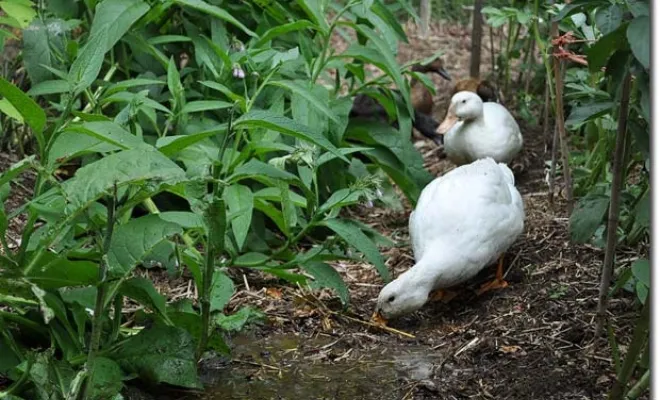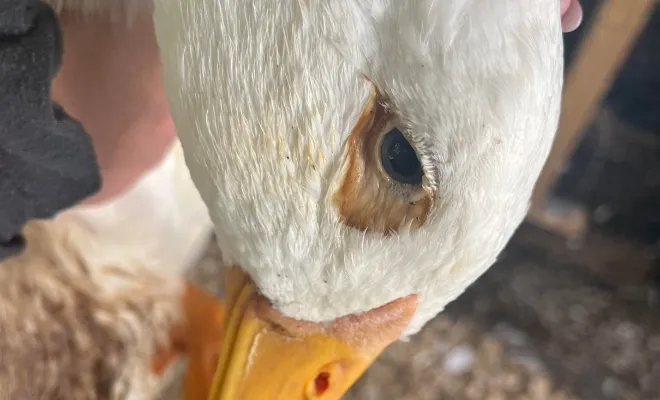9 Easy Steps to Build the Perfect Duck House In Your Pond!

Do you have a lovely pond in your backyard that attracts ducks? If so, consider building a duck house for them. Building a duck house is a great DIY project that can be completed on a weekend. With a little skill, it’s easy for the beginner to experts!
But, how to build a duck house on a pond? To build a duck house, gather your material, first. Then, construct the house by building a simple box, and anchor and position the house. Also, maintain the coop area to keep it clean and safe for the feathered friends.
However, let’s learn how to build a waterfowl house in the pond. Get the materials and follow the given steps!
Table of Contents
How to Build A Duck House On A Pond? A Complete Guide!
Building a duck house on a pond is a good job that helps both ducks and people who own ponds.
The duck house keeps ducks safe from bad weather and predators. Putting it near the water makes it easy for ducks to get to.
Using the right design and materials is super important for making a perfect floating duck house.
However, building one is easy if you follow the steps one by one.
Duck House Design and Planning
Before you start building your duck house, it’s important to plan carefully. Here’s what you need to think about.
Consider how many ducks you have or plan to have. Aim for about 4 square feet of floor space per adult duck. The overall height can be around 3-4 feet for comfortable movement inside.
Give them comfy bedding like hay or wood shavings. For laying ducks, add a special nesting box. Pick a calm spot on the pond away from strong winds and currents. Make sure there’s shallow water nearby.
Watch out for predators like raccoons or foxes! Keep the house away from trees or structures that might give them easy access.
Add small holes near the top of the house for ventilation. Include a roof that opens up or sections that can be removed.
Opt for weather-resistant materials like cedar or redwood to withstand outdoor elements. Treated plywood can also be an option.
Floating Duck Housing Materials
When choosing materials for your floating duck house, prioritize durability and safety for the ducks. But, what do you use to float a duck house?
Something to Make it Float
Cedar or redwood are good because they resist rot and bugs, but make sure it’s treated for water. You can also use marine-grade plywood with a waterproof coating.
If you’re recycling, use food-grade plastic barrels and seal them tight to stop leaks.
Strong Walls and Roof
Like the base, make sure it’s treated wood for water. PVC panels are light, waterproof, and easy to use. But might not look as nice.
Metal sheets are tough but heavy and harder to work with. Use Rust-Proof Hardware or stainless steel screws, nails, and hinges. These things don’t rust from being in the water. Cover the entrance with strong wire mesh. It’s to keep the chickens safe from predators like raccoons.
Soft Bedding
Put wood shavings or hay inside for nesting ducks. A little ramp can help ducks. It’s especially babies, that get in and out easily.
Choosing the Right Location
Choosing a suitable location for your duck house will directly contribute to their safety. Here’s what you need to follow:
- Elevation and Drainage: Put your duck house on higher ground to avoid water building up when it rains a lot. Look for soil that drains well, like sandy soil that dries fast after rain.
- Near Water: Ducks need water nearby to stay healthy. Put the duck house close to your pond or another water source. Make sure the water is deep enough for swimming and cleaning.
- Flight Path and Privacy: Clear the way to the duck house so ducks can fly in easily. Face the entrance towards the water for privacy. Ducks like peace, so keep the house away from busy places.
- Keeping Predators Away: Pick a spot where animals like raccoons and foxes can’t get to the ducks easily. Lift the duck house off the ground to make it harder for them to reach.
- Sun and Shade: Ducks like a mix of sun and shade. Find a spot that gets some sunlight during the day but also has shady spots. Avoid putting the duck house where it’ll be in direct sun all day. Make sure you’ve heat lamps for baby chicks.
- Wind Protection: Put the duck house where it’s sheltered from strong winds. Ducks prefer calm places. Trees or bushes can help block the wind.
- Easy to Reach: Make sure you can get to the duck house easily for cleaning and fixing it. Don’t put it too far from your house or other buildings.
We’ll make a budget-friendly floating DIY duck house project.
Building the Duck House: A Step-by-step Process
Building a duck house near a pond involves several steps to create a safe and comfortable shelter. Let’s check out the process:
Step 1. Plan and Gather Materials
Decide on the size and shape of your duck house. It should be spacious enough for ducks to move comfortably. But not too large to maintain!
Step 2. Duck House Construction Plan with Layout
Pencil-draw the different pieces onto the wood. Measure twice and cut once to ensure accuracy.
Step 3. Create the Following Components
Make the back, two sides, front, floor, and roof. The roof’s back edge should be cut at a 20-degree angle to fit flush with the back of the box. The entrance hole should be 3″ high by 4″ wide, positioned 19.” It’s above the base of the front part.
Step 4. Dry Fit and Adjust
Assemble the parts without fastening them. Check dimensions and angles. Make any necessary adjustments before proceeding.
Step 5. Create Traction and Ventilation
Ducks need a rough surface for traction when leaving the nest. Set the saw to make shallow kerf cuts on the interior and exterior. Ensure proper ventilation to maintain air quality inside the duck house.
Step 6. Assemble the Duck House
Use exterior deck screws (2″) for durability. Pre-drill holes to avoid splitting the wood. Attach the pieces, including the nesting box area.
Make sure you have a designated clean-out door for easy maintenance.
Step 7. Roof and Watertight Design
Attach the roof securely to the frame. Slope the roof away from the box to ensure it’s watertight. Ducks appreciate a dry interior.
Step 8. Elevate and Place Near the Water
Elevate the duck house to prevent flooding during heavy rains. Position it near the water’s edge for easy access.
Step 9. Adding Finishing Touches
You can sand the exterior for a smoother finish. Also, paint it with waterproof paint if desired.
Secure the house to a stable platform that floats securely on the pond. Ensure the platform can withstand the weight of the house.
Related articles:
Environment Considerations
When making duck houses, the environment has a big role. So, keep the following things in mind –
- Check with local authorities before building.
- Use eco-friendly stuff or pick materials that are good for the Earth. For example – recycled materials or wood from sustainable sources.
- When building, try not to mess up the area around the pond. Don’t tear up plants or dig too much.
- Use safe stuff for the duck house and don’t use harsh chemicals.
- Don’t give ducks too much food. It can mess up the pond. Give them just enough and don’t leave food lying around.
- Keep an eye on the pond after you build the duck house. If you see any problems, like too much algae, change what you’re doing.
- You can also ask experts for help.
Extra Tips: Plant native plants around the pond to give ducks natural food. Make sure there are lots of different plants and bugs in the pond.
Maintaining the Duck House
After making the pond house for ducks, be sure you maintain some facts –
- Clean the duck house twice a year. It’s before and after nesting season.
- Remove old bedding, droppings, and dirt. Use gentle cleaning solutions and let it dry well.
- Change soft bedding often. Ensure the hygiene!
- Keep your eyes on the ventilation process for the duck house. Be sure they get airs all the time.
- Be sure ducks always get water for swimming, drinking, and preening.
- Put out duck food near the house, especially in winter.
Have a look at the video to get more ideas for making the perfect duck coop. It will be a budget-friendly DIY duck house in the pond.
If you are filthy rich and have enough space, the given video can make the best duck house. Seems like a heaven for the duck!
Benefits of Having a Duck House in the Pond
Making a pond house for ducks is a gift for them. Here’s how they get the benefit –
For Ducks
- Pond houses are a haven from predators, weather, and temperature extremes.
- Less expensive to raise than other livestock.
- You may see drakes are less likely to fight than roosters.
- They become quieter than chickens, especially roosters.
For Pond Owners
- Ducks eat bugs and insects, helping to control populations.
- They become less destructive to gardens than chickens.
- Their droppings provide natural fertilizer.
- Feathers can be used for various purposes.
Note: As per research findings, duck droppings are rich in nutrients that easily dissolve in water. It provides a valuable source for plankton growth. Also, duck excrement enhances nutrient levels within fish pond ecosystems.
How Much to Spend on a Duck House in the Pond?
Consider building your own do-it-yourself duck house if you have the skills and tools. But if you expect it from experts, here are the cost ideas you can keep in mind.
| Budget Level | Estimated Cost | Description |
|---|---|---|
| Do-It-Yourself (DIY) | $25 – $100 | This option allows for customization and cost savings. Requires materials, tools, and building skills. |
| Pre-built Basic | $50 – $200 | Offers readily available and functional options. May lack customization features. |
| Pre-built Feature-Rich | $100 – $500 | Includes features like nesting boxes, ramps, and predator-proof mesh. May require assembly. |
| Luxury or Custom-Built | $500+ | Offers high-quality materials, intricate designs, and unique features. May involve professional builders or manufacturers. |
13 Inspiring Best Duck House Ideas in the Pond
The best duck house depends on your specific needs, resources, and desired aesthetics. However, the following ideas can be perfect for every duck enthusiast.
- Classic A-Frame: This simple, triangle-shaped house is sturdy and keeps ducks safe. Whether it’s from weather and predators, ducks will be safe! It’s easy to build and can have extra features like nesting boxes and special mesh.
- Rustic Barrel House: Use old wooden barrels to make cozy homes for ducks. Make sure there’s enough air and protection from animals.
- Geodesic Dome Duck House: Construct a geodesic dome-shaped duck house using triangular panels. It’s sturdy, efficient, and visually appealing.
- Cob-style Duck House: Create a cozy cob-style house using natural materials like clay, straw, and sand. The rounded design provides insulation and a rustic look.
- Floating Oasis: Ducks will love this house on a floating platform. Add a ramp so even baby ducks can get in and out easily.
- Elevated Retreat: If your pond is shallow, put the duck house on a platform above the water. It keeps ducks safe and dry.
- Multi-Level Mansion: This big house is perfect for lots of ducks. It can have different rooms, decks, and even a swimming area!
- Eco-Friendly Haven: Make this house using old stuff like pallets or wood. It’s good for the Earth and saves money.
- Natural Hideaway: Blend this house in with nature using branches and plants. It looks nice and is good for ducks.
- Cozy Cottage: This house looks like a tiny house! Ducks will love it, but make sure it’s safe from animals.
- Island Getaway: Put this house on its own little island in a big pond. It’s quiet and safe for ducks.
- Winterized Sanctuary: Keep ducks warm in winter with this house. It’s cozy and has insulation to keep them snug.
- Repurposed Doll House: Transform an old dollhouse into a charming duck coop. Add a ramp for easy access and nesting boxes for egg-laying.
FAQs
Ensure you check the following queries about building a DIY house for ducks. I include some other untold facts.
Q. How do I attract ducks to my pond?
To attract the ducks in the pond, give them shallow water. Keep the pond open in winter with an aeration system.
You can also plant aquatic vegetation. For example – duckweed, water lettuce, or other plants. Nesting sites attract them, too.
Q. What are the alternatives to duck house in the pond?
Instead of a duck house in the pond, offer them natural shelter. Include more vegetation in the natural pond. For example – bushes, tree branches, and fallen logs.
Make a secure nesting box near the water. Or use predator deterrence like fences, motion-activated sprinklers, or predator decoys.
Conclusion
Building a duck house on your pond is not just a project! It’s a journey of creating a haven for both you and our feathered friends. Following these steps, you’ll craft a safe and cozy shelter, adding to the charm of your pond.
Remember to keep in mind the environment and upkeep. It’s to ensure a happy home for the ducks and a thriving ecosystem. Whether you choose a humble A-frame or a grand mansion, your efforts will reward you. And it’s what duck enthusiasts will surely do for their ducks!






